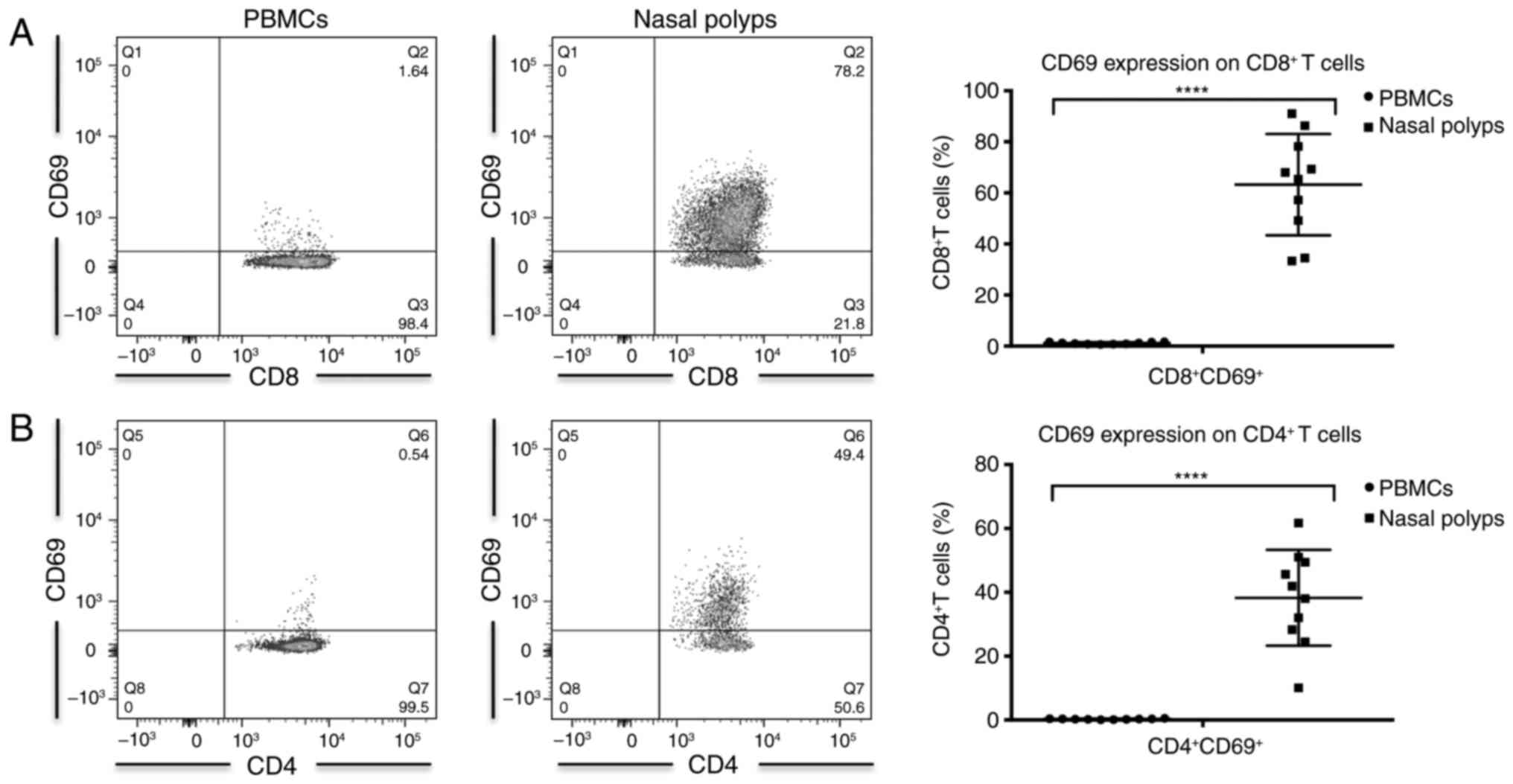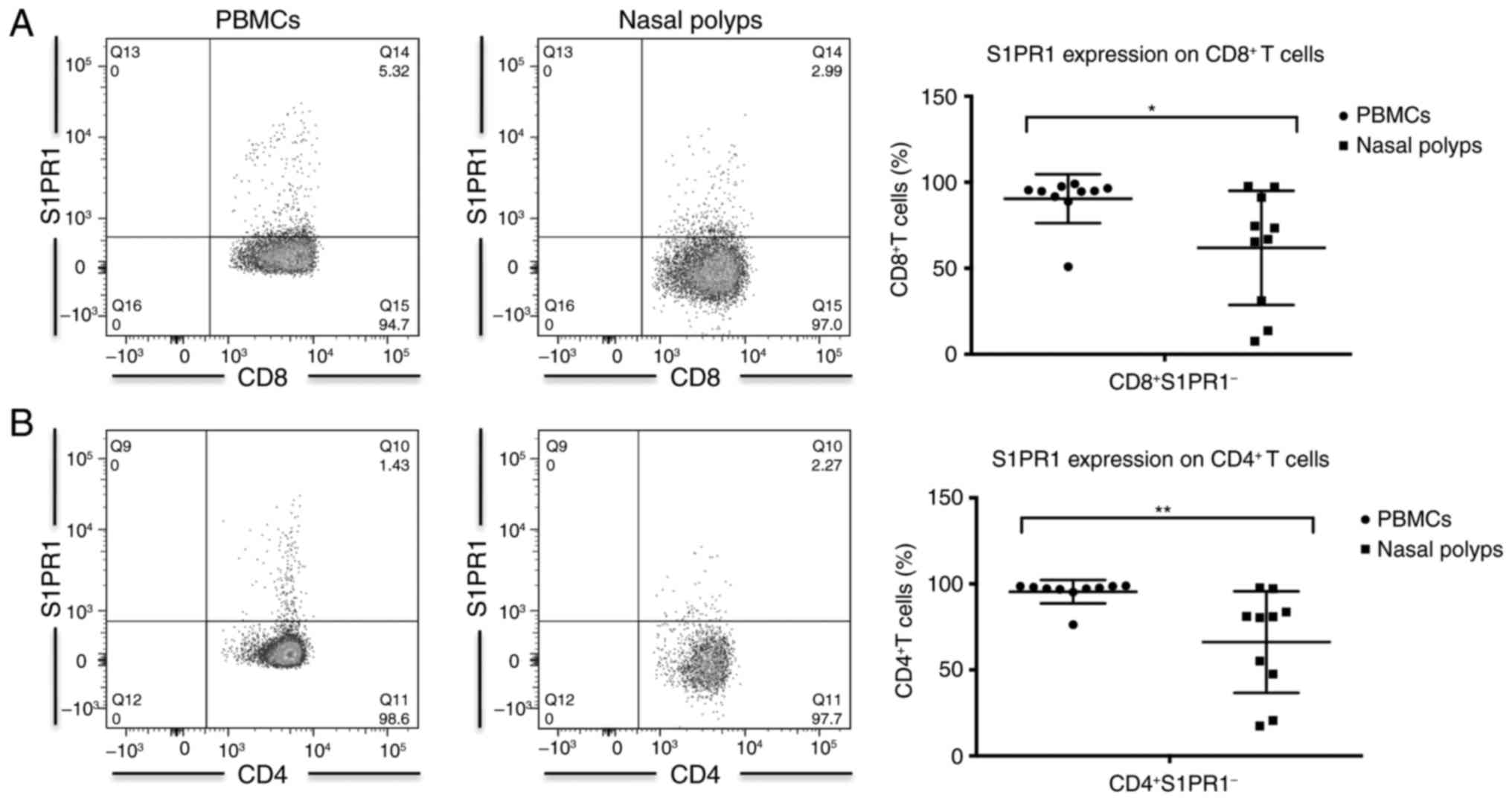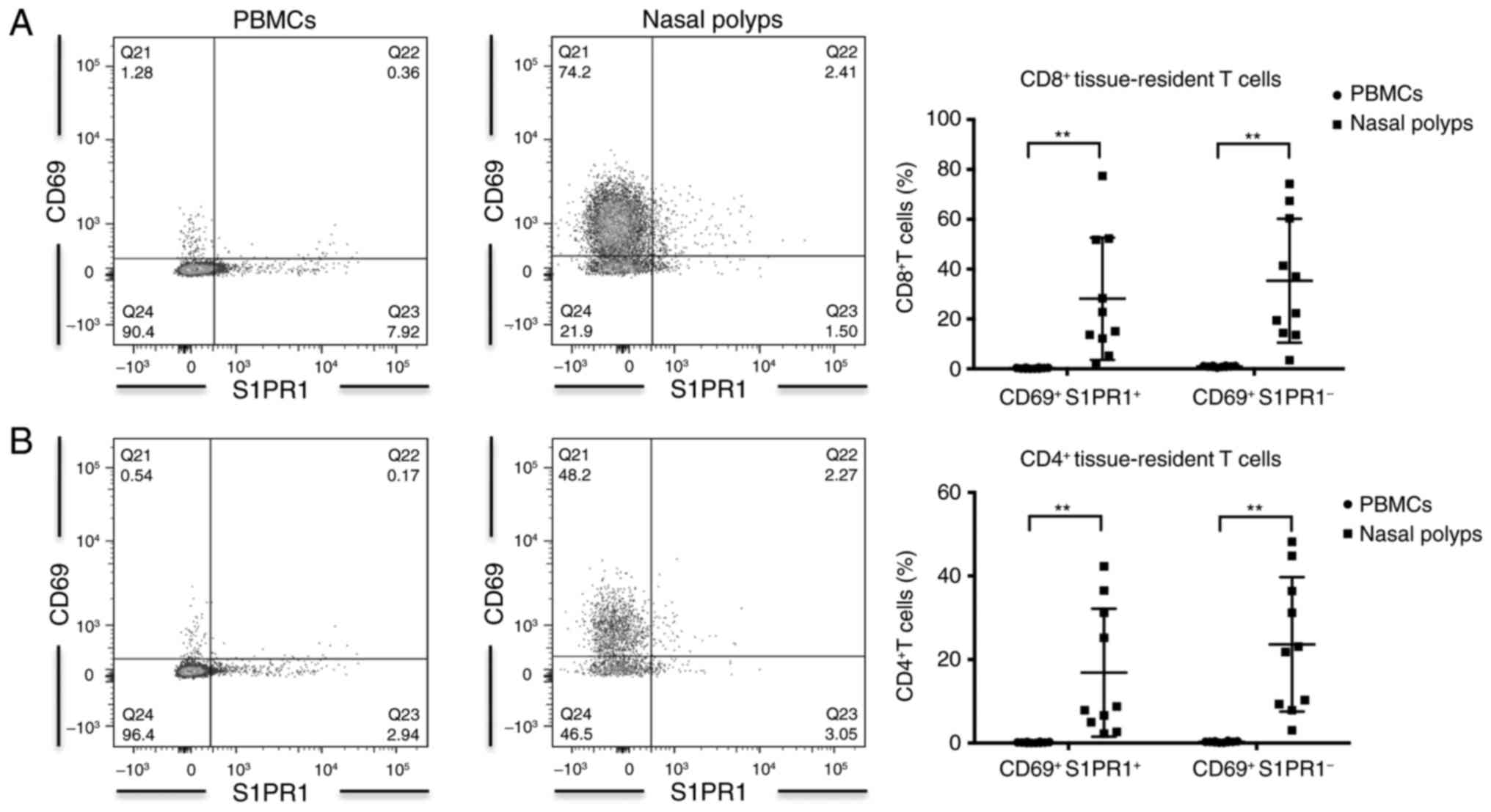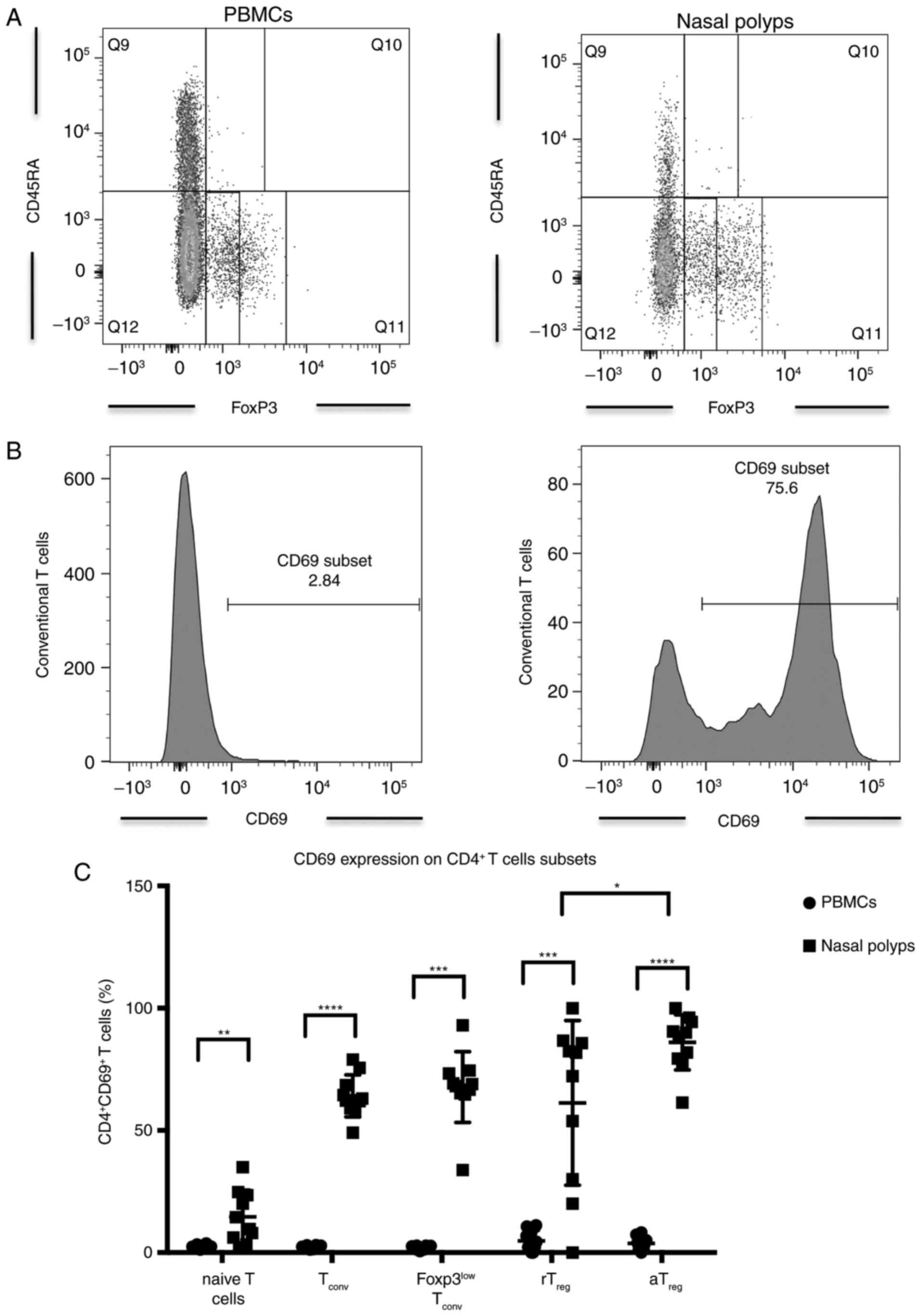|
1
|
Bachert C and Akdis CA: Phenotypes and
emerging endotypes of chronic rhinosinusitis. J Allergy Clin
Immunol Pract. 4:621–628. 2016. View Article : Google Scholar : PubMed/NCBI
|
|
2
|
Ickrath P, Kleinsasser N, Ding X, Ginzkey
C, Beyersdorf N, Hagen R, Kerkau T and Hackenberg S:
Characterization of T-cell subpopulations in patients with chronic
rhinosinusitis with nasal polyposis. Allergy Rhinol (Providence).
8:139–147. 2017. View Article : Google Scholar
|
|
3
|
Miyara M, Yoshioka Y, Kitoh A, Shima T,
Wing K, Niwa A, Parizot C, Taflin C, Heike T, Valeyre D, et al:
Functional delineation and differentiation dynamics of human
CD4+ T cells expressing the FoxP3 transcription factor.
Immunity. 30:899–911. 2009. View Article : Google Scholar : PubMed/NCBI
|
|
4
|
Ponikau JU, Sherris DA, Kern EB, Homburger
HA, Frigas E, Gaffey TA and Roberts GD: The diagnosis and incidence
of allergic fungal sinusitis. Mayo Clin Proc. 74:877–884. 1999.
View Article : Google Scholar : PubMed/NCBI
|
|
5
|
Pant H, Hughes A, Miljkovic D, Schembri M,
Wormald P, Macardle P, Grose R, Zola H and Krumbiegel D:
Accumulation of effector memory CD8+ T cells in nasal
polyps. Am J Rhinol Allergy. 27:e117–e126. 2013. View Article : Google Scholar : PubMed/NCBI
|
|
6
|
Pant H and Macardle P: CD8(+) T cells
implicated in the pathogenesis of allergic fungal rhinosinusitis.
Allergy Rhinol (Providence). 5:146–156. 2014. View Article : Google Scholar
|
|
7
|
Bachert C, Zhang N, Patou J, van Zele T
and Gevaert P: Role of staphylococcal superantigens in upper airway
disease. Curr Opin Allergy Clin Immunol. 8:34–38. 2008. View Article : Google Scholar : PubMed/NCBI
|
|
8
|
Van Zele T, Gevaert P, Holtappels G, van
Cauwenberge P and Bachert C: Local immunoglobulin production in
nasal polyposis is modulated by superantigens. Clin Exp Allergy.
37:1840–1847. 2007. View Article : Google Scholar : PubMed/NCBI
|
|
9
|
Ickrath P, Kleinsasser N, Ding X, Ginzkey
C, Beyersdorf N, Kerkau T, Hagen R and Hackenberg S: Impact and
modulations of peripheral and edaphic B cell subpopulations in
chronic rhino-sinusitis with nasal polyposis. Clin Exp
Otorhinolaryngol. Feb 8–2018.Epub ahead of print. View Article : Google Scholar
|
|
10
|
Bromley SK, Thomas SY and Luster AD:
Chemokine receptor CCR7 guides T cell exit from peripheral tissues
and entry into afferent lymphatics. Nat Immunol. 6:895–901. 2005.
View Article : Google Scholar : PubMed/NCBI
|
|
11
|
Matloubian M, Lo CG, Cinamon G, Lesneski
MJ, Xu Y, Brinkmann V, Allende ML, Proia RL and Cyster JG:
Lymphocyte egress from thymus and peripheral lymphoid organs is
dependent on S1P receptor 1. Nature. 427:355–360. 2004. View Article : Google Scholar : PubMed/NCBI
|
|
12
|
Skon CN, Lee JY, Anderson KG, Masopust D,
Hogquist KA and Jameson SC: Transcriptional downregulation of S1pr1
is required for the establishment of resident memory
CD8+ T cells. Nat Immunol. 14:1285–1293. 2013.
View Article : Google Scholar : PubMed/NCBI
|
|
13
|
Mackay LK, Braun A, Macleod BL, Collins N,
Tebartz C, Bedoui S, Carbone FR and Gebhardt T: Cutting edge: CD69
interference with sphingosine-1-phosphate receptor function
regulates peripheral T cell retention. J Immunol. 194:2059–2063.
2015. View Article : Google Scholar : PubMed/NCBI
|
|
14
|
Schenkel JM and Masopust D:
Tissue-resident memory T cells. Immunity. 41:886–897. 2014.
View Article : Google Scholar : PubMed/NCBI
|
|
15
|
Brown MN, Fintushel SR, Lee MH, Jennrich
S, Geherin SA, Hay JB, Butcher EC and Debes GF: Chemoattractant
receptors and lymphocyte egress from extralymphoid tissue: Changing
requirements during the course of inflammation. J Immunol.
185:4873–4882. 2010. View Article : Google Scholar : PubMed/NCBI
|
|
16
|
Jiang X, Clark RA, Liu L, Wagers AJ,
Fuhlbrigge RC and Kupper TS: Skin infection generates non-migratory
memory CD8+ T(RM) cells providing global skin immunity.
Nature. 483:227–231. 2012. View Article : Google Scholar : PubMed/NCBI
|
|
17
|
Schrijvers R, Gilissen L, Chiriac AM and
Demoly P: Pathogenesis and diagnosis of delayed-type drug
hypersensitivity reactions, from bedside to bench and back. Clin
Transl Allergy. 5:312015. View Article : Google Scholar : PubMed/NCBI
|
|
18
|
Aoki M, Aoki H, Ramanathan R, Hait NC and
Takabe K: Sphingosine-1-phosphate signaling in immune cells and
inflammation: Roles and therapeutic potential. Mediators Inflamm.
2016:86068782016.PubMed/NCBI
|
|
19
|
Ma C, Mishra S, Demel EL, Liu Y and Zhang
N: TGF-β controls the formation of kidney-resident T cells via
promoting effector T cell extravasation. J Immunol. 198:749–756.
2016. View Article : Google Scholar
|
|
20
|
Bergsbaken T and Bevan MJ: Proinflammatory
microenvironments within the intestine regulate the differentiation
of tissue-resident CD8(+) T cells responding to infection. Nat
Immunol. 16:406–414. 2015. View Article : Google Scholar : PubMed/NCBI
|
|
21
|
Wang X, Zhang N, Bo M, Holtappels G, Zheng
M, Lou H, Wang H, Zhang L and Bachert C: Diversity of TH cytokine
profiles in patients with chronic rhinosinusitis: A multicenter
study in Europe, Asia, and Oceania. J Allergy Clin Immunol.
138:1344–1353. 2016. View Article : Google Scholar : PubMed/NCBI
|
|
22
|
Mackay LK and Kallies A: Transcriptional
regulation of tissue-resident lymphocytes. Trends Immunol.
38:94–103. 2017. View Article : Google Scholar
|
|
23
|
Anderson KG, Sung H, Skon CN, Lefrancois
L, Deisinger A, Vezys V and Masopust D: Cutting edge: Intravascular
staining redefines lung CD8 T cell responses. J Immunol.
189:2702–2706. 2012. View Article : Google Scholar : PubMed/NCBI
|
|
24
|
Casey KA, Fraser KA, Schenkel JM, Moran A,
Abt MC, Beura LK, Lucas PJ, Artis D, Wherry EJ, Hogquist K, et al:
Antigen-independent differentiation and maintenance of
effector-like resident memory T cells in tissues. J Immunol.
188:4866–4875. 2012. View Article : Google Scholar : PubMed/NCBI
|
|
25
|
Sallusto F, Lenig D, Forster R, Lipp M and
Lanzavecchia A: Two subsets of memory T lymphocytes with distinct
homing potentials and effector functions. Nature. 401:708–712.
1999. View Article : Google Scholar : PubMed/NCBI
|
|
26
|
Steinert EM, Schenkel JM, Fraser KA, Beura
LK, Manlove LS, Igyártó BZ, Southern PJ and Masopust D: Quantifying
memory CD8 T cells reveals regionalization of immunosurveillance.
Cell. 161:737–749. 2015. View Article : Google Scholar : PubMed/NCBI
|
|
27
|
Steinbach K, Vincenti I, Kreutzfeldt M,
Page N, Muschaweckh A, Wagner I, Drexler I, Pinschewer D, Korn T
and Merkler D: Brain-resident memory T cells represent an
autonomous cytotoxic barrier to viral infection. J Exp Med.
213:1571–1587. 2016. View Article : Google Scholar : PubMed/NCBI
|
|
28
|
Gebhardt T, Whitney PG, Zaid A, Mackay LK,
Brooks AG, Heath WR, Carbone FR and Mueller SN: Different patterns
of peripheral migration by memory CD4+ and
CD8+ T cells. Nature. 477:216–219. 2011. View Article : Google Scholar : PubMed/NCBI
|
|
29
|
Sakaguchi S, Yamaguchi T, Nomura T and Ono
M: Regulatory T cells and immune tolerance. Cell. 133:775–787.
2008. View Article : Google Scholar : PubMed/NCBI
|
|
30
|
Robinson DS: The role of regulatory T
lymphocytes in asthma pathogenesis. Curr Allergy Asthma Rep.
5:136–141. 2005. View Article : Google Scholar : PubMed/NCBI
|
|
31
|
Lynch L, Michelet X, Zhang S, Brennan PJ,
Moseman A, Lester C, Besra G, Vomhof-Dekrey EE, Tighe M, Koay HF,
et al: Regulatory iNKT cells lack expression of the transcription
factor PLZF and control the homeostasis of T(reg) cells and
macrophages in adipose tissue. Nat Immunol. 16:85–95. 2015.
View Article : Google Scholar
|
|
32
|
Luo CT, Liao W, Dadi S, Toure A and Li MO:
Graded Foxo1 activity in Treg cells differentiates tumour immunity
from spontaneous autoimmunity. Nature. 529:532–536. 2016.
View Article : Google Scholar : PubMed/NCBI
|
|
33
|
Schmidt JD, Ahlström MG, Johansen JD,
Dyring-Andersen B, Agerbeck C, Nielsen MM, Poulsen SS, Woetmann A,
Ødum N, Thomsen AR, et al: Rapid allergen-induced interleukin-17
and interferon-γ secretion by skin-resident memory CD8+
T cells. Contact Dermatitis. 76:218–227. 2016. View Article : Google Scholar
|
|
34
|
Park CO and Kupper TS: The emerging role
of resident memory T cells in protective immunity and inflammatory
disease. Nat Med. 21:688–697. 2015. View Article : Google Scholar : PubMed/NCBI
|
|
35
|
Sathaliyawala T, Kubota M, Yudanin N,
Turner D, Camp P, Thome JJ, Bickham KL, Lerner H, Goldstein M,
Sykes M, et al: Distribution and compartmentalization of human
circulating and tissue-resident memory T cell subsets. Immunity.
38:187–197. 2013. View Article : Google Scholar :
|













